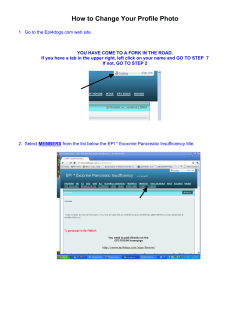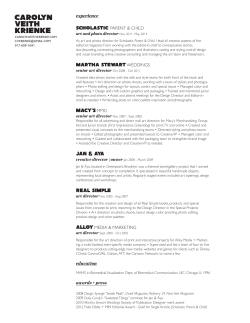
Technical note How To Maintain a VFD
Technical note How To Maintain a VFD Do you know how to maintain Variable Frequency Drives (VFDs)? Doing so is easier than you might think. By integrating some simple, logical steps into your preventative maintenance program, you can ensure your drives provide many years of trouble-free service. Before looking at those steps, let’s quickly review what a VFD is and how it works. A Quick Overview A VFD controls the speed, torque and direction of an AC Induction motor. It takes xed voltage and frequency AC input and converts it to a variable voltage and frequency AC output. See Training Note “What is a VFD? ” available at www.abbdrives.com for a more detailed description of VFD concepts and operating principles. In very small VFDs, a single power pack unit may contain the converter and inverter. Fairly involved control circuitry coordinates the switching of power devices, typically through a control board that dictates the ring of power components in the proper sequence. A microprocessor or Digital Signal Processor (DSP) meets all the internal logic and decision requirements. From this description, you can see a VFD is basically a computer and power supply. And the same safety and equipment precautions you’d apply to a computer and to a power supply apply here. VFD maintenance requirements fall into three basic categories: −− keep it clean; −− keep it dry; and −− keep the connections tight. −− Let’s look at each of these. Keep it Clean Most VFDs fall into the NEMA 1 category (side vents for cooling airow) or NEMA 12 category (sealed, dust-tight enclosure). Drives that fall in the NEMA 1 category are susceptible to dust contamination. Dust on VFD hardware can cause a lack of airow, resulting in diminished performance from heat sinks and circulating fans (Photo 1). Dust on an electronic device can cause malfunction or even failure. Dust absorbs moisture, which also contributes to Photo 1, Fan Injecting Dust into Drive Enclosure failure. Periodically spraying air through the heat sink fan is a good PM measure. Discharging compressed air into a VFD is a viable option in some environments, but typical plant air contains oil and water. To use compressed air for cooling, you must use air that is oil-free and dry or you are likely to do more harm than good. That requires a specialized, dedicated, and expensive air supply. And you still run the risk of generating electrostatic charges (ESD). A non-static generating spray or a reverse-operated ESD vacuum will reduce static build-up. Common plastics are prime generators of static electricity. The material in ESD vacuum cases and fans is a special, non-static generating plastic. These vacuums, and cans of non-static generating compressed air, are available through companies that specialize in static control equipment. Keep it Dry In Photo 2 you can see what happened to a control board periodically subjected to a moist environment. Initially, this VFD was wall-mounted in a clean, dry area of a mechanical room and moisture was not a problem. However, as is often the case, a well-meaning modication led to problems. In this example, an area of the building required a dehumidier close to the mechanical room. Since wall space was available above the VFD, this is where the dehumidier went. Unfortunately, the VFD was a NEMA 1 enclosure style (side vents and no seal around the cover). The obvious result was water dripping from the dehumidifier into the drive. In six months, the VFD accumulated enough water to produce circuit board corrosion. Photo 3, Arcing Caused by Loose Input Contacts Photo 2, Corrosion on Board Traces Caused by Moisture What about condensation? Some VFD manufacturers included a type of “condensation protection” on earlier product versions. When the mercury dipped below 32 degrees Fahrenheit, the software logic would not allow the drive to start. VFDs seldom offer this protection today. If you operate the VFD all day every day, the normal radiant heat from the heatsink should prevent condensation. Unless the unit is in continuous operation, use a NEMA 12 enclosure and thermostatically controlled space heater if you locate it where condensation is likely. Keep Connections Tight While this sounds basic, checking connections is a step many people miss or do incorrectly - and the requirement applies even in clean rooms. Heat cycles and mechanical vibration can lead to sub-standard connections, as can standard PM practices. Retorquing screws is not a good idea, and further tightening an already tight connection can ruin the connection (see Sidebar). Bad connections eventually lead to arcing. Arcing at the VFD input could result in nuisance over voltage faults, clearing of input fuses, or damage to protective components. Arcing at the VFD output could result in over-current faults, or even damage to the power components. Photos 3 and 4 show what can happen. Loose control wiring connections can cause erratic operation. For example, a loose START/STOP signal wire can cause uncontrollable VFD stops. A loose speed reference wire can cause the drive speed to fluctuate, resulting in scrap, machine damage, or personnel injury. Photo 4, Arcing Caused by Loose Output Contacts Additional Steps 1. As part of a mechanical inspection procedure, don’t overlook internal VFD components. Check circulating fans for signs of bearing failure or foreign objects - usually indicated by unusual noise or shafts that appear wobbly. 2. Inspect DC bus capacitors for bulging and leakage. Either could be a sign of component stress or electrical misuse. Photos 5 and 6 show fan and capacitor stress problems. 3. Take voltage measurements while the VFD is in operation. Fluctuations in DC bus voltage measurements can indicate degradation of DC bus capacitors. One function of the capacitor bank is to act as a lter section (smoothing out any AC ripple voltage on the Bus). Abnormal AC voltage on the DC bus indicates the capacitors are headed for trouble. Most VFD manufacturers have a special terminal block for this type of measurement and also for connection of the dynamic braking resistors. Measurements more than 4VAC may indicate a capacitor ltering problem or a possible problem with the diode bridge converter section (ahead of the bus). If you have such voltage levels, consult the VFD manufacturer before taking With the VFD in START and at zero speed, you should read output voltage of 40VAC phase-to-phase or less. If you read more than this, you may have transistor leakage. At zero speed, the power components should not be operating. If your readings are 60VAC or more, you can expect power component failure. Photo 5, Foreign Object in Fan 4. What about spare VFDs? Store them in a clean, dry environment, with no condensation allowed. Place this unit in your PM system so you know to power it up every 6 months to keep the DC bus capacitors at their peak performance capability. Otherwise, their charging ability will signicantly diminish. A capacitor is much like a battery-it needs to go into service soon after purchase or suffer a loss of usable life. as low as -10 degrees Fahrenheit. A VFD, which is basically a computer with a power supply, needs the same consideration. Some VFD manufacturers advertise 200,000 hours-almost 23 years-of Mean Time Between Failures (MTBF). Such impressive performance is easy to obtain, if you follow these simple procedures. Side bar: Re-torquing - A Screwy Practice Although “re-torquing” as a way of checking tightness is common in many PM procedures, it violates basic mechanical principles and does more harm than good. A screw has maximum clamping power at a torque value specific to its size, shape, and composition. Exceeding that torque value permanently reduces the clamping power of that screw by reducing its elasticity and deforming it. Loosening and then re-torquing still reduces elasticity, which still means a loss of clamping power. Doing this to a lock washer results in a permanent 50% loss. What should you do? Use an infrared thermometer to note hot connections. Check their torque. If they have merely worked loose, you can try retightening them. Note which screws were loose, and be sure to give them an IR check at the next PM cycle. If they are loose again, replace them. Finally, don’t forget the “tug test.” This checks crimps, as well as screw connections. Don’t do this with the drive online with the process, though, or you may cause some very expensive process disturbances. For more information please contact: ABB Inc. Low Voltage Drives 16250 W. Glendale Drive New Berlin, WI 53151 Phone: (800) 752-0696 Fax: (262) 785-0397 www.abb.us/drives Photo 6, Capacitor Failure 5. Regularly monitor heat sink temperatures. Most VFD manufacturers make this task easy by including a direct temperature readout on the Keypad or display. Verify where this readout is, and make checking it part of a weekly or monthly review of VFD operation. You wouldn’t place your laptop computer outside, on the roof of a building or in direct sunlight, where temperatures could reach 115 degrees Fahrenheit or LVD-EOTN02U-EN REVA Effective: 08/20/2007 further action.
© Copyright 2025














